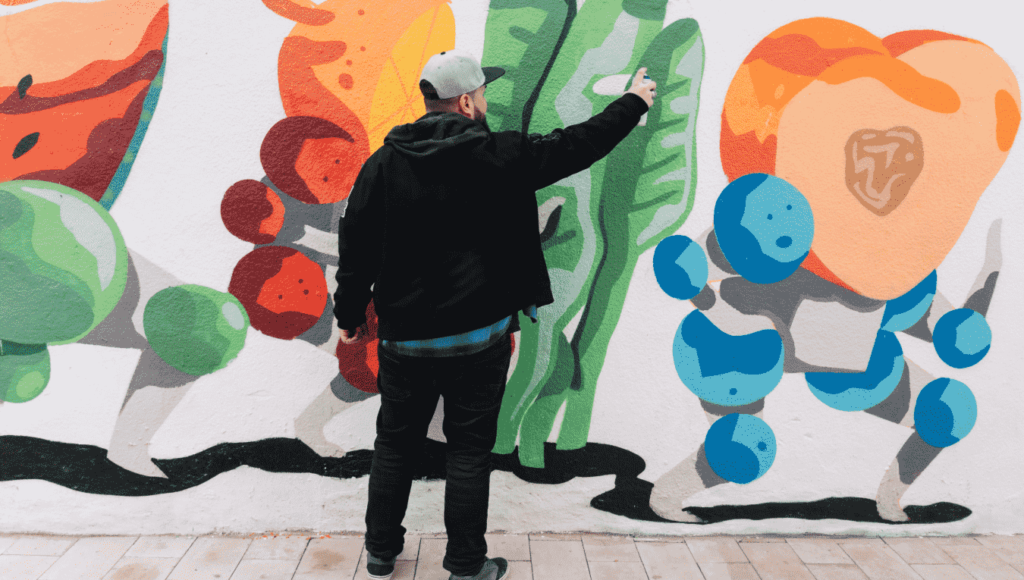Art
Exploring Street Art: From Graffiti to Murals
by: Podelit

Have you ever walked down a city street and been captivated by the vibrant colors, intricate designs, or bold statements on its walls? That’s street art—an art form that has transformed public spaces, turning ordinary urban landscapes into powerful expressions of creativity, rebellion, and culture. From simple graffiti tags to large-scale murals, street art has evolved into a global movement that speaks to people in unique and often profound ways.
In this blog, we’ll dive into the world of street art, exploring its history, the different forms it takes, and the impact it has on communities. Whether you’re a street art enthusiast or just curious about this fascinating art form, this post will give you a deeper understanding of how street art has shaped our cities and cultures.
What Is Street Art?
Street art refers to visual art created in public spaces, often outside of traditional galleries and museums. It includes a wide range of artistic expressions—ranging from quick graffiti tags sprayed on a sidewalk to meticulously painted murals on building walls.
While street art originated in the underground world of graffiti, it has expanded to include various forms such as stencils, paste-ups, and even 3D installations. What makes street art unique is its accessibility; it’s public, often interactive, and sometimes temporary. This art form blurs the lines between rebellion and artistry, offering a powerful platform for self-expression, social commentary, and even political protest.
The History of Street Art
Street art has a rich history that dates back to the early 1970s, when graffiti first emerged in the streets of New York City. Young artists, often with little formal training, began spray-painting their names or “tags” on subway cars and buildings, creating a new form of public art. While many saw it as an act of vandalism, others viewed it as a legitimate art form that gave voice to marginalized communities.
By the 1980s, street art started to gain mainstream attention. Artists like Jean-Michel Basquiat and Keith Haring, both of whom started their careers in the streets, began to bridge the gap between underground street culture and the established art world. Street art’s rise was also fueled by the proliferation of hip-hop culture, which embraced graffiti as a symbol of artistic freedom and rebellion.
Fast forward to today, and street art is not just confined to cities but has become a global phenomenon. Artists like Banksy, Shepard Fairey, and JR have elevated the art form, with large-scale murals and thought-provoking political statements. What was once considered vandalism is now celebrated in galleries and museums worldwide.
Types of Street Art
Street art comes in many shapes and sizes, each form offering a unique perspective and style. Let’s explore some of the most common types:
1. Graffiti Tags
Graffiti tags are the most basic and recognizable form of street art. They typically consist of an artist’s signature or symbol sprayed on a wall or surface. While tags may seem simple, they can carry deep personal meaning for the artist, acting as a form of self-expression or identity.
2. Murals
Murals are large-scale, detailed works of art that cover entire walls or buildings. These pieces often tell stories, address social issues, or beautify urban spaces. Murals can be highly intricate and are sometimes created in collaboration with communities or local governments. Notable muralists like Diego Rivera and David Siqueiros have used the medium to address political themes, while contemporary muralists continue to create stunning works that connect with the public.
3. Stencil Art
Stencil art involves using pre-cut templates to apply paint to a surface. Artists like Banksy and Blek le Rat popularized this technique, which allows for precision and the ability to create multiple iterations of the same image. Stencils are often used for creating sharp, iconic images with social or political messages.
4. Paste-Ups
Paste-ups are pre-made art pieces that are glued to public surfaces. These can include posters, drawings, or digital prints. Paste-ups are an effective way for street artists to share their work in a quick and accessible way, as the artwork can be easily reproduced and distributed.
5. 3D Installations
Some street artists take things to the next level with 3D installations, which incorporate elements of sculpture and urban space. These installations can interact with their surroundings, using objects and even the architecture of the environment to create an immersive experience for the viewer.
The Cultural Impact of Street Art
Street art is much more than just decoration—it has a significant cultural and social impact. Often, street art serves as a form of activism, addressing issues such as inequality, political unrest, and social justice. Through their art, street artists can challenge the status quo, express dissent, and raise awareness about pressing global issues.
In addition to its political messages, street art plays an important role in revitalizing neighborhoods. What was once a forgotten, rundown area can be transformed by a colorful mural or a well-placed piece of art. This process, known as “gentrification through art,” can breathe new life into communities, attract tourists, and even encourage local businesses to flourish.
Many cities, like Berlin, New York, and São Paulo, have embraced street art as a way to beautify their urban landscapes. In some cases, local governments have even commissioned murals and street art to enhance public spaces. These murals often reflect the local culture, history, and struggles, creating a deep connection between the artwork and the community.
Iconic Street Art Destinations
Some cities are particularly well-known for their vibrant street art scenes. If you’re an art enthusiast or simply curious, here are some must-visit locations where street art takes center stage:
- Berlin, Germany: Known for its iconic East Side Gallery, a stretch of the Berlin Wall covered in art, Berlin has become a global street art hub. The city’s Kreuzberg district is filled with murals and graffiti, offering a unique blend of history and creativity.
- London, UK: Shoreditch is a mecca for street art in London. The area is constantly evolving, with new pieces popping up on almost every corner. Artists like Banksy have left their mark here, making London a hotspot for street art lovers.
- Miami, USA: Miami’s Wynwood Walls is a famous outdoor museum showcasing murals by some of the world’s top street artists. The colorful neighborhood has become a focal point for contemporary street art.
- São Paulo, Brazil: The largest city in Brazil is known for its stunning murals that cover entire buildings. Artists like Os Gemeos and Eduardo Kobra have transformed São Paulo’s streets into a canvas for vibrant, large-scale works.
Challenges and Controversies
While street art is celebrated in many circles, it’s not without its controversies. One of the main challenges is the fine line between street art and vandalism. In many places, creating art on public property without permission is considered illegal, and artists can face fines or even jail time.
Additionally, the commercialization of street art has sparked debate. Some argue that when street art is moved from public spaces to galleries or auctioned for large sums, it loses its authenticity. Others believe that the increasing recognition of street art has helped elevate it to the level of fine art, giving artists the opportunity to make a living from their craft.
How to Appreciate and Support Street Art
Whether you’re an avid street art enthusiast or someone who’s just starting to explore, here are a few ways you can appreciate and support street art:
- Explore Your Local Street Art Scene: Take a walk around your city and look for murals, graffiti, and installations. Many cities have street art tours that guide you through the most famous works.
- Support the Artists: Attend street art festivals, purchase prints or original works, or share street art on social media to help artists gain exposure.
- Get Involved: If you’re a budding artist, why not try your hand at street art? Remember to always get permission if you’re creating on public property, or explore legal spaces designated for graffiti and murals.
Street art has evolved from its humble, rebellious roots into a celebrated global art form that continues to influence culture, politics, and society. Whether through graffiti, murals, or installations, street art brings creativity to the streets and has the power to transform communities, inspire dialogue, and challenge norms.
Next time you walk through a city, take a moment to appreciate the stories being told on the walls around you. Street art is more than just paint—it’s a reflection of the human experience, capturing our dreams, struggles, and triumphs in the most unexpected places.
Let’s celebrate this art form and the talented individuals who bring color and meaning to the urban landscape.


